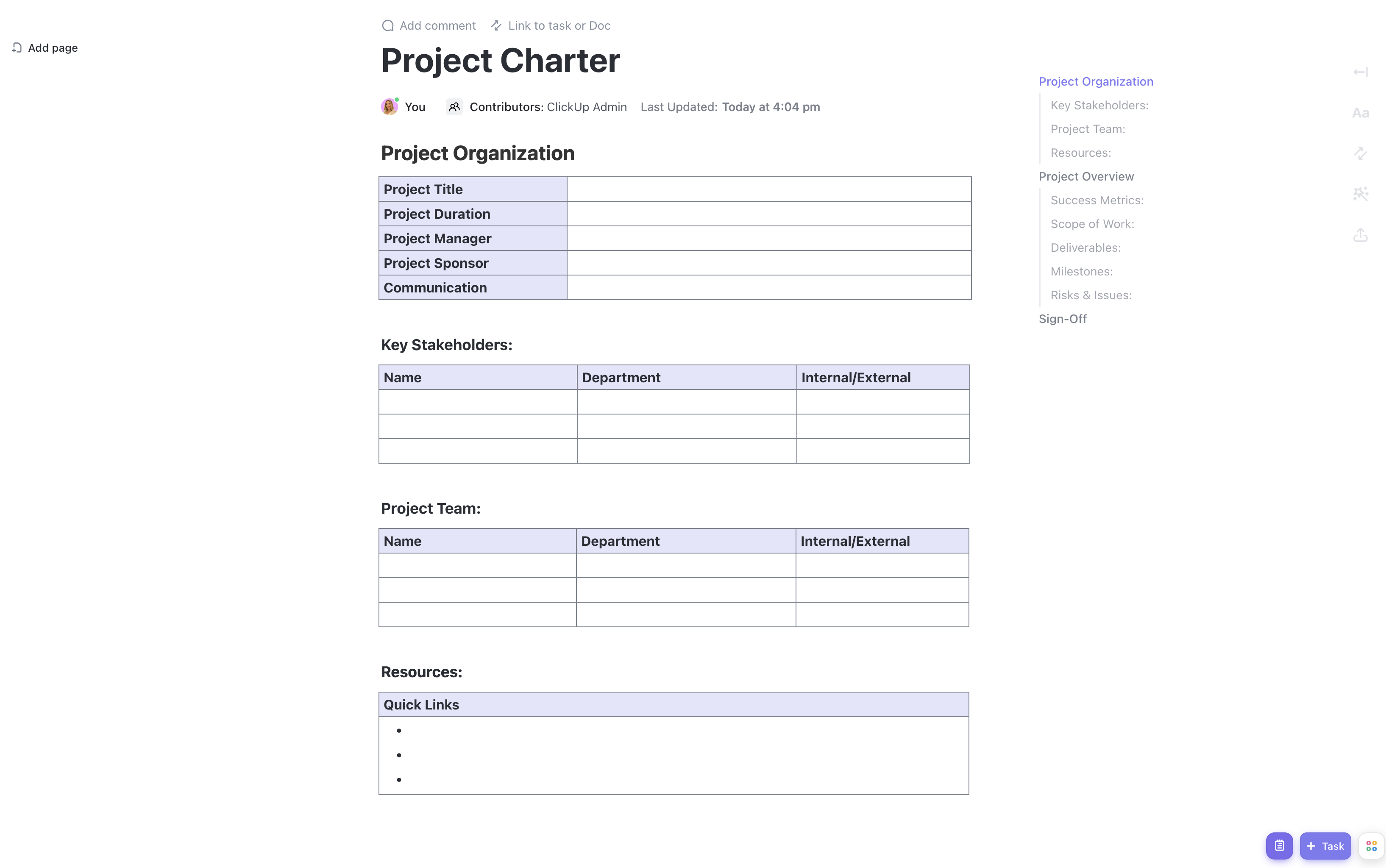Embarking on a game development project can feel like stepping into a whole new world. With so many moving parts and creative ideas to bring to life, staying organized is essential. That's where ClickUp's Game Development Project Charter Template comes to the rescue!
This template is designed to help you:
- Define clear project objectives and scope
- Outline roles and responsibilities for your team members
- Establish a realistic timeline and milestone goals
- Track and manage resources for smooth development
- Coordinate collaboration and communication across teams
Whether you're an indie developer or part of a big studio, this template will guide you through the entire game development process, from concept to launch. Take your game to the next level with ClickUp's Game Development Project Charter Template and start creating your masterpiece today!
Benefits of Game Development Project Charter Template
Creating a Game Development Project Charter using ClickUp's template can provide numerous benefits for your game development team. Some of these benefits include:
- Clearly defining project objectives, scope, and deliverables
- Establishing a timeline and milestones to keep the project on track
- Identifying and allocating necessary resources, such as team members and budget
- Outlining roles and responsibilities to ensure everyone knows their tasks
- Facilitating effective communication and collaboration among team members
- Providing a structured framework for risk management and issue resolution
- Ensuring alignment with stakeholders' expectations and requirements
- Increasing overall project efficiency and success rate.
Main Elements of Game Development Project Charter Template
ClickUp's Game Development Project Charter template is the perfect tool to kickstart your game development project. Here are the main elements of this Doc template:
- Custom Statuses: Track the progress of your game development project with custom statuses tailored to your workflow, such as Planning, In Progress, Testing, and Completed.
- Custom Fields: Utilize custom fields to capture essential information about your game, including Platform, Genre, Release Date, and Target Audience, ensuring all project details are easily accessible and organized.
- Different Views: View your game development project from different perspectives with ClickUp's versatile views. Choose from List View to see all project details at a glance, Board View for a visual representation of tasks, or Calendar View to manage deadlines and milestones effectively.
With ClickUp's Game Development Project Charter template, you'll have all the necessary tools to plan, execute, and track your game development project seamlessly.
How to Use Project Charter for Game Developers
If you're embarking on a game development project, it's essential to start off on the right foot. Follow these steps to effectively use the Game Development Project Charter Template in ClickUp:
1. Define your project scope and objectives
Before diving into the development process, it's crucial to clearly define the scope and objectives of your game project. Determine the genre, platform, target audience, and any specific features or mechanics you want to include. This will help set the foundation for your project and ensure that everyone involved is on the same page.
Use the Goals feature in ClickUp to outline and document your project scope and objectives.
2. Identify key stakeholders and team members
Identify the key stakeholders and team members who will be involved in the game development process. This may include game designers, developers, artists, sound engineers, and project managers. Assign roles and responsibilities to each team member to ensure a smooth workflow and efficient collaboration.
Create tasks in ClickUp and assign them to the appropriate team members to keep track of everyone's responsibilities.
3. Establish project deliverables and milestones
Determine the specific deliverables and milestones that need to be achieved throughout the game development process. This could include completing character designs, implementing gameplay mechanics, creating levels, and conducting playtesting sessions. Breaking down the project into smaller, manageable tasks will help you stay organized and track progress.
Use Milestones in ClickUp to set important deadlines and track the completion of key project deliverables.
4. Monitor progress and adapt as needed
As the game development project progresses, it's essential to monitor the progress and make necessary adjustments. Regularly review the project charter and assess if any changes or updates need to be made. Additionally, use the project charter as a reference point to evaluate if the project is aligning with the initial objectives and if any modifications are required.
Set up recurring tasks in ClickUp to regularly review and update the project charter, ensuring that it remains relevant and reflects the current state of the game development project.
By following these steps and utilizing the Game Development Project Charter Template in ClickUp, you can effectively plan and execute your game development project, ensuring a successful and well-coordinated effort from start to finish.

Get Started with ClickUp's Game Development Project Charter Template
Game developers can use this Game Development Project Charter Template to help everyone stay on the same page when it comes to planning and executing game development projects.
First, hit “Get Free Solution” to sign up for ClickUp and add the template to your Workspace. Make sure you designate which Space or location in your Workspace you’d like this template applied.
Next, invite relevant members or guests to your Workspace to start collaborating.
Now you can take advantage of the full potential of this template to create amazing games:
- Use the Game Design View to brainstorm game ideas and plan out game mechanics
- The Project Schedule View will help you create a timeline for each phase of the game development process
- Use the Resource Allocation View to assign tasks and manage workload for each team member
- The Gantt Chart View will give you a visual representation of the project timeline and dependencies
- Organize tasks into different statuses to keep track of progress
- Update statuses as you complete tasks to keep team members informed of progress
- Monitor and analyze tasks to ensure maximum productivity









